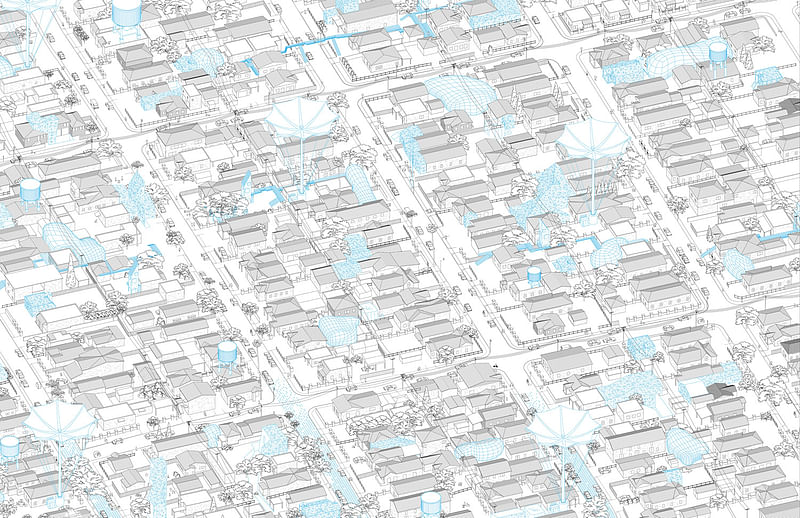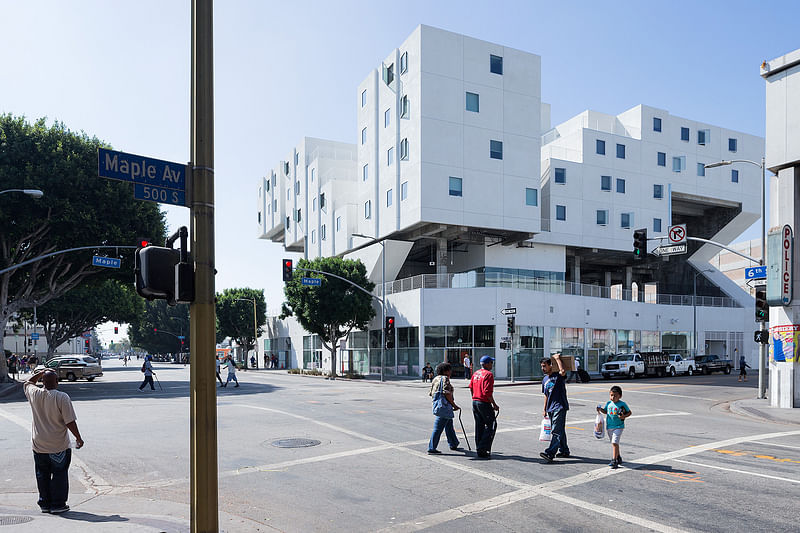Re-imagining new forms of Los Angeles "Shelter", opening today at the A+D Museum
By Bustler Editors|
Thursday, Aug 20, 2015

Related
Like several major cities in the U.S., Los Angeles faces increasing density, skyrocketing rent prices, and decreasing amounts of buildable land — among other problems. Opening at the A+D Museum tonight in downtown L.A., the "Shelter: Rethinking How We Live in Los Angeles" exhibition explores new possibilities of housing design in the Southland with engaging projects by a notable roster of architects.
Read on for more details.
Co-curated by Sam Lubell and Danielle Rago, the exhibition features both speculative as well as recently constructed and in-progress housing proposals that address the city's evolving cultural and physical landscape.
Be on the lookout for works by firms like Bureau Spectacular, Bestor Architecture, Michael Maltzan Architecture, PAR, OMA, MAD Architects, LA Más, and more.
Get a glimpse of the projects that will be on display at the A+D starting August 20 until November 6, 2015.

Five Normal Houses: The L.A. River Story
by Bureau Spectacular
"Along the L.A. River, there is a language within the typologies of domestic architecture. This raises an important question: Just what makes a house normal in L.A.? If the word shelter suggests a lack of extravagance, what are some of the qualities of 'normal' architectural languages in Southern California, and how are they constituted? Is it possible to study the techniques of normal, and produce almost normal architecture?
Bureau Spectacular embarked on field research along the river. When they returned, they noted five conditions to pursue. The wet and dry pool cultures, the fascination with vegetation on facades, the car culture and the dingbat, the physical de-compartmentalization of a domestic unit, and the asymmetrical mash-up of Spanish Styles or Queen Anne Revivals. The firm proposes five applications of normal vocabularies of domestic architecture, spoken with some sense of hyperbole."

Backyard Basics: An Alternative Story of the Granny Flat
by LA-Más
"In Elysian Valley, also known as Frogtown, the rising tide of developer-led speculation and neighborhood-wide fear brings into question the nature of new development, and how future projects can and should support housing, affordability, and mixed-use. LA-Más proposes a resident-led and resident-owned model for low-rise high-density housing. By critically engaging lot lines and speculative buildable space level this strategy reconsiders the granny flat as a collective development area capable of supporting studio and one-bedroom apartments through cooperative development, combined entitlements, and consolidated services.
The firm has structured combinations of two and four collective lots to accommodate a variety of uses. E ach grouping has at least one shared parking entrance, with direct access cores leading to raised granny flats. The firm has also organized each block end with shared parking hubs and shared bike stations to coordinate a larger community transit plan, allowing for increased density without taxing the already at-capacity infrastructure of the residential streets abutting the Los Angeles River."

WATERshed
by LORCAN O’HERLIHY ARCHITECTS [LOHA]
"Lorcan O’Herlihy Architects investigates the relationship between urbanization and water use to develop new models of densification that tap into existing ecological and infrastructural patterns. By occupying publicly and privately owned land remnants and capitalizing on the redundan cies created by outdated land use and infrastructure networks, a new model for urban regeneration can emerge .
In these traditionally overlooked residual spaces, LOHA has designed a system of interventions at multiple scales, combining living, public space and water-based infrastructure into a hybrid patchwork that will capture, recycle, purify, loop, and reconnect ground and storm water back to the water table and the Los Angeles River. The network of interventions makes the best use of limited space and finite ecological resources, developing an urban culture that sets in motion critical transformations."

Cloud Corridor
MAD
"With new facilities being planned for the Los Angeles County Museum of Art (LACMA), the Academy Museum of Motion Pictures, the Petersen Museum, and the Purple Line Metro, L.A.’s Museum Row — one of the city’s cultural epicenters — needs to activate its community after museum hours. MAD places residential architecture at the 'front door' of the area’s institutions.
Among L.A.’s sprawling street grid and multiple city centers, Cloud Corridor offers a contemporary housing typology — the vertical village — to connect the disparate neighborhoods surrounding Museum Row by redistributing density and creating a sense of community. Cloud Corrid or transforms everyday urban experiences into opportunities for residents to interact with nature. An undulating podium provides public space and acts as the base for nine sinuous towers that feature floating garden patios with connective landings and bridges."

6030 Wilshire
by PAR
"PAR offers a new model for high - rise courtyard housing, integrated with mass transit, on LACMA’s proposed tower site on Wilshire Boulevard in the Miracle Mile. The tower typology, an important element in the contemporary metropolis, has become anonymous, d efined mainly by its height. Typical residential skyscrapers, while successfully providing density, rarely produce unique living environments with access to green space, qualities that are emblematic of Los Angeles living. PAR’s proposal acts against this endemic monotony, creating a 930-foot-tall stack of individual houses, each with a direct connection to nature through extended terraces, some containing common spaces and leisure zones."

UN \ FOLDING WILSHIRE
by wHY
"wHY’s Ideas Workshop examines the inter section of physical, social, and regulatory space to alleviate pressure on Los Angeles’ housing accessibility, diversity, and affordability. Raising the question: How do we manage our shrinking resources, increasing population, and ‘accepted’ cost of living? Using public space along Wilshire Boulevard’s Metro Purple Line, this new landscape inhabits the grey zone between regulation and disorder, and challenges our expectations of ownership, how projects are funded and how they are built.
Drawing inspiration from the shared economy and our changing transportation expectations (including automated vehicles), the infrastructure can accommodate a new mini-city that sustains itself through community and shared resources. wHY demonstrates the proposed infrastructure in a playful way, reflecting on the seemingly endless roadways and hodgepodge architectural expressions that define our perceptions of Los Angeles."

Star Apartments, Downtown Los Angeles, 2014
by Michael Maltzan Architecture
"Located in Los Angeles' Skid Row neighborhood, Star Apartments transforms an existing single-story commercial building into a mixed-used residential complex with 102 apartments for formerly homeless individuals. The six-story, 95,000 square foot building sets a new model for housing, urbanism, and density within the city. The building is organized around three spatial zones stacked one upon the other: a commercial/retail zone at street level; a second level for community programs; and four terraced floors of residences above.
The first floor encompasses a residents’ lobby as well as the new headquarters of the LA County Department of Health Services Housing for Health Division with a medical clinic for the Skid Row community. The second floor features numerous common spaces for the building's residents including open-air patios, a community kitchen, meeting room, art room, running/walking track, a pickle ball court and 2,000 square feet of edible gardens.
The LEED for Homes Platinum project, completed in 2014, was constructed using prefabricated modular units stacked on a new concrete superstructure. Individual units were built off-site, delivered to the project site, and craned into place.
Overall, the design facilitates a recovery process for residents based on positive re-socialization and healthy interpersonal relations with a strong emphasis on wellness. With terraces for communal and rehabilitative activities, the design maximizes natural light and ventilation and encourages safe social activities. Apartments are spacious and designed to promote independent, healthy living. The project seeks to improve the quality of life for residents and inspire a sense of pride, independence, and dignity."

Blackbirds, Echo Park, 2015
by Bestor Architecture
"Blackbirds is a cluster of eighteen houses that are embedded in the hills of Echo Park, Los Angeles. The multi-house development is a progressive design solution for high-quality dense housing in a city with little available land. The houses range from 1200 to 1900 squ are feet and are built around a living street; a central courtyard that comprises both landscape and parking areas, and serves as a stage for larger community functions and play.
The placement of the houses in the hills mimics the older wooden houses of the area, and deploys a strategy of “stealth density”, combining several houses into a single house - shaped volume. For instance, two free - standing houses are connected by flashing a nd the roofline creates the illusion of one house mass. Three houses, whose separation is masked, creates the illusion of two houses. This conceals the actual density of units by maintaining the neighborhood shape and landscape context across the site. The community is a blend of private, semi - private, and public space, and promotes a sense of neighborhood by encouraging interaction and exchange.
More event info here.

Share
0 Comments
Comment as :